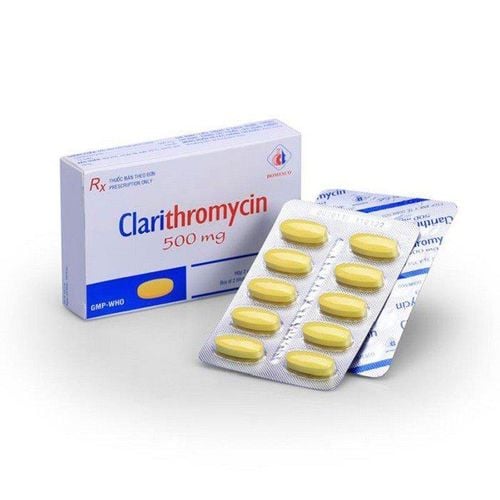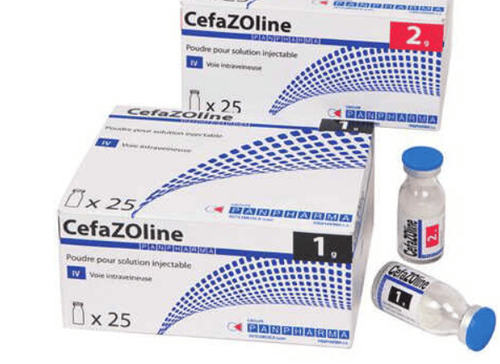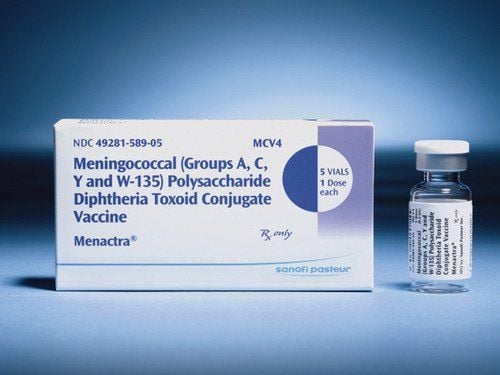This is an automatically translated article.
CeftaZidime 2g is commonly used mainly in the treatment of severe infections caused by strains of Gram-negative bacteria. Patients should carefully read the instructions, follow the doctor's recommendations to use the drug safely.
1. What is CeftaZidime?
CeftaZidime 2g is a prescription medicine used to treat severe infections caused by Gram-negative bacteria. CeftaZidime 2g is currently a product of TV Pharmaceutical Joint Stock Company. Pharm - Vietnam, prepared in the form of a powder for injection and packed according to the box specifications of 1 vial with 1 ampoule of 10ml distilled water for injection.
In each bottle of powder for injection CeftaZidime 2g contains the main active ingredient is Ceftazidime 2g and some other excipients just enough. CeftaZidime has a shelf life of 36 months from the date of manufacture indicated on the package. To ensure the safety and effectiveness of treatment as expected, patients need to carefully read the instructions for use of CeftaZidime and follow the instructions of the doctor.
2. Uses of the drug CeftaZidime 2g
The active ingredient Ceftazidime is known for its strong bactericidal effect due to its ability to inhibit enzymes that synthesize the bacterial cell wall. According to research, Ceftazidime is stable to most bacterial beta-lactamases, except Bacteroides enzymes. In addition, Ceftazidime is also sensitive to most strains of Gram-negative bacteria that are resistant to Aminoglycosides and some strains of Gram-positive bacteria resistant to Cephalosporins and other ampicillins.Active ingredient Ceftazidime has good effect on the following strains of bacteria:
Gram-negative aerobic bacteria such as Shigella, Salmonella, E.coli, Proteus, Pseudomonas, Haemophylus influenzae, Klebsiella,... Some strains of Moraxella catarrhalis, Pneumococcus and Streptococcus viridans. Gram-positive anaerobic strains are susceptible to Ceftazidime.
3. Indications and contraindications to the use of CeftaZidime 2g
3.1. Indications for use of the drug CeftaZidime 2g Currently, the drug CeftaZidime 2g is often prescribed by doctors to treat severe bacterial infections caused by Gram-negative bacteria, including:
Meningitis. Sepsis. Urinary tract infections appear complications. Bone and joint infections. Lower respiratory tract infections. Bacterial infections in mucous diseases. Bacterial infection in the abdomen. Gynecological infections. Skin or soft tissue infections, including wound and burn infections. 3.2. Contraindications to the use of CeftaZidime 2g CeftaZidime 2g should be avoided in the following patients without the approval of a doctor:
Patients with a history of allergy or hypersensitivity reactions to penicillins and cephalosporins. Relative contraindications CeftaZidime 2g for pregnant women or nursing mothers.
4. Dosage and instructions for using CeftaZidime 2g
4.1. How much should CeftaZidime 2g be taken? CeftaZidime 2g is used as prescribed by the doctor with the recommended dosage below:
*CeftaZidime 2g dose for adults:
Usual dose: Deep intramuscular or intravenous 1g CeftaZidime, each injection spaced approximately 8 - 12 hours. Dosage for treatment of immunocompromised diseases or meningitis caused by Gram-negative bacteria: Inject 2g of CeftaZidime, about 8 hours apart for each dose. Dosage for urinary tract infections: Inject about 500mg of CeftaZidime, every 12 hours. Dose for elderly patients (> 70 years): Need to reduce to 1/2 dose within 24 hours compared to normal people. CeftaZidime can be used in elderly patients up to 3g/day. * Dosage of CeftaZidime 2g for children:
Infants and children < 12 months: Inject dose 25-60mg/kg body weight/day, divided into 2 times, each dose is about 12 hours apart. Children > 2 months: Inject dose 30-100mg/kg body weight/day, divided into 2-3 times, each dose is 8-12 hours apart. An increase in the dose for children with severe infections may be considered up to 150 mg/kg body weight/day in 3 divided doses, but should not exceed 6 g/day. Children over 8 days old with meningitis: Use a dose of 50mg / kg body weight / 12 hours. * Dosage of CeftaZidime 2g for patients with renal impairment:
Elderly patients with impaired renal function: Dosage of CeftaZidime depends on creatinine clearance. Patients with renal impairment: Use a starting dose of CeftaZidime 1g, then use a maintenance dose determined based on creatinine clearance, specifically: Clearance from 50 to 31ml/min: Inject 1g dose every 12 hours. Clearance from 30 to 60 ml/min: 1g dose every 24 hours. Clearance from 15 to 6ml/min: 0.5g dose every 24 hours. Clearance < 5ml/min: 0.5g dose every 48 hours. *CeftaZidime 2g dose for other cases:
Treatment of infections in viscous diseases: An increase in dose to 50% may be considered. Treatment of patients on hemodialysis: Add 1g of CeftaZidime at the end of each dialysis session. Treatment for patients undergoing continuous arteriovenous dialysis: Use a dose of 1g CeftaZidime/day, which can be divided into several times or injected once. Treatment for patients undergoing peritoneal dialysis: Use an initial dose of CeftaZidime 1g, then a dose of 500mg/24 hours. 4.2. How to use CeftaZidime 2g effectively and safely CeftaZidime 2g is prepared in the form of a powder for injection, so the drug will be administered by intramuscular, injection or intravenous infusion. Here are instructions on how to prepare CeftaZidime 2g for each use:
Mixing solution for intramuscular injection: Mix CeftaZidime 2g with about 3ml of distilled water for injection or 1% or 5% Lidocaine hydrochloride solution to obtain The final solution contains CeftaZidime at a concentration of about 250 mg/ml. For intravenous solution: Mix CeftaZidime powder with 10ml of distilled water for injection, 5% Dextrose or 0.9% NaCl solution to obtain a final solution containing CeftaZidime with a concentration of 90mg/ml. The drug should be given slowly intravenously over 3-5 minutes. Prepare solution for intravenous infusion: Mix CeftaZidime powder with 100ml of distilled water for injection, 5% Dextrose or 0.9% NaCl solution to obtain a final solution containing CeftaZidime with a concentration of about 10mg/ml. 4.3. How to deal with an overdose of CeftaZidime 2g When injecting an overdose of CeftaZidime 2g, patients may experience symptoms such as neuromuscular excitability, encephalopathy, convulsions or tremors (for humans). kidney failure). When there are warning signs of an overdose of CeftaZidime 2g, the patient should immediately notify the doctor for a solution. Your doctor may recommend symptomatic treatment of overdose and rapid elimination of the drug from the body by peritoneal dialysis or hemodialysis.
5. What side effects can CeftaZidime 2g cause?
Below are some unwanted side effects that patients may experience during treatment with CeftaZidime 2g:
Common side effects: Injection site irritation, itching, thrombophlebitis, allergic reaction , exanthematous or gastrointestinal reactions. Uncommon side effects: Dizziness, fever, headache, anaphylaxis, Quincke's edema, thrombocytopenia, eosinophilia, increased lymphocytes, neutropenia, leukopenia, dysgeusia or positive Coombs test. Patients should tell their doctor immediately if they experience any of the side effects mentioned above while taking CeftaZidime 2g.
6. What precautions and precautions should be taken when using CeftaZidime 2g?
Before and during the treatment of infections caused by Gram-negative bacteria with CeftaZidime 2g, the patient should be cautious of the following:
Carefully check the patient's history of allergy to Cephalosporin antibiotics or Penicillin before treatment with CeftaZidime 2g. There is a risk of cross-reactivity between Cephalosporins and Penicillins. Although CeftaZidime 2g does not cause nephrotoxicity, caution should be exercised if co-administered with nephrotoxic drugs. Monitor prothrombin time in people with liver failure, kidney failure, or malnutrition. CeftaZidime 2g should be used with caution in patients with a history of gastrointestinal disease. CeftaZidime 2g should be used by pregnant and lactating women only when the benefits outweigh the risks and it is absolutely necessary.
7. Interactions of CeftaZidime 2g with other drugs
The drug CeftaZidime 2g when used in combination with the following drugs may have an interaction reaction, including:
Drugs that are toxic to the body, such as Furosemide or Aminoglycoside. If co-administration is required, the patient's renal function should be monitored during treatment. Chloramphenicol can cause in vitro antagonism when co-administered with CeftaZidime 2g. The article has provided information about the uses, doses and precautions when using CeftaZidime 2g. To ensure safety for health and maximize the effectiveness of treatment, patients need to take CeftaZidime 2g exactly as directed by their doctor.
Please dial HOTLINE for more information or register for an appointment HERE. Download MyVinmec app to make appointments faster and to manage your bookings easily.













